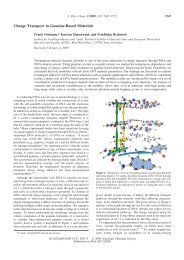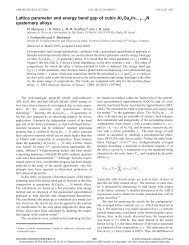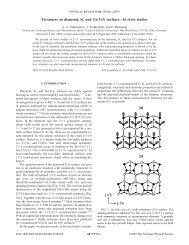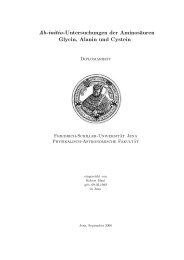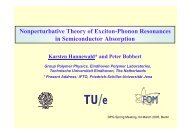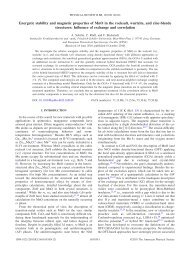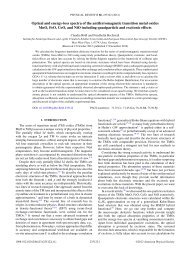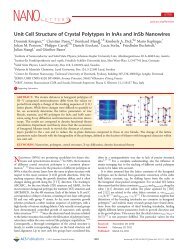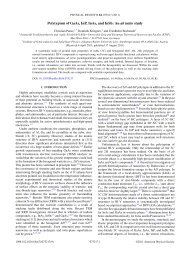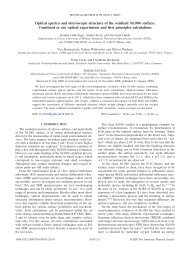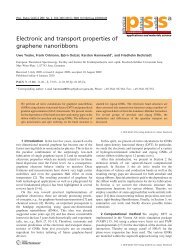Structure and energetics of Ga-rich GaAs(001) surfaces - Institut für ...
Structure and energetics of Ga-rich GaAs(001) surfaces - Institut für ...
Structure and energetics of Ga-rich GaAs(001) surfaces - Institut für ...
You also want an ePaper? Increase the reach of your titles
YUMPU automatically turns print PDFs into web optimized ePapers that Google loves.
Surface Science 507–510 (2002) 406–410<br />
www.elsevier.com/locate/susc<br />
<strong>Structure</strong> <strong>and</strong> <strong>energetics</strong> <strong>of</strong> <strong>Ga</strong>-<strong>rich</strong> <strong>Ga</strong>As(<strong>001</strong>) <strong>surfaces</strong><br />
K. Seino a, *<br />
, W.G. Schmidt a , F. Bechstedt a , J. Bernholc b<br />
a <strong>Institut</strong> f€ur Festk€orpertheorie und Theoretische Optik, Fried<strong>rich</strong>-Schiller-Universit€at, Max-Wien-Platz 1, 07743 Jena, Germany<br />
b Department <strong>of</strong> Physics, North Carolina State University, Raleigh, NC 27695-8202, USA<br />
Abstract<br />
The atomic structures <strong>and</strong> energies <strong>of</strong> <strong>Ga</strong>-<strong>rich</strong> <strong>Ga</strong>As(0 0 1) surface reconstructions are examined by means <strong>of</strong> firstprinciples<br />
total-energy calculations based on a real-space multigrid method. Our calculations confirm the existence <strong>of</strong><br />
the novel f(4 2) structure suggested by Lee et al. [Phys. Rev. Lett. 85 (2000) 3890]. (4 6) surface reconstructions<br />
suggested to explain STM experiments are found to be unstable. The calculations indicate that the adsorption <strong>of</strong> <strong>Ga</strong><br />
adatoms in the trenches <strong>of</strong> the f(4 2) surface could possibly explain the observed structures. The diffusion <strong>of</strong> <strong>Ga</strong>/As<br />
adatoms on the <strong>Ga</strong>-<strong>rich</strong> <strong>Ga</strong>As surface is predicted to be anisotropic <strong>and</strong> should preferably take place parallel to the<br />
[1 1 0]/[1 1 0] direction, respectively. Ó 2002 Elsevier Science B.V. All rights reserved.<br />
Keywords: <strong>Ga</strong>llium arsenide; Single crystal <strong>surfaces</strong>; Density functional calculations; Surface diffusion<br />
1. Introduction<br />
The <strong>Ga</strong>As(0 0 1) surface belongs to the most<br />
intensively investigated compound semiconductor<br />
<strong>surfaces</strong>. Its stoichiometry-dependent geometries<br />
seemed to be well established from both experiment<br />
<strong>and</strong> theory [1]. These geometries were used as<br />
starting points for further calculations such as kinetic<br />
Monte Carlo studies on the <strong>Ga</strong>As surface<br />
growth (see, e.g., Ref. [2]). Recent computational<br />
studies [3,4], however, provided new insight into<br />
the microscopic structure <strong>of</strong> the stoichiometric<br />
(2 4) <strong>and</strong> the <strong>Ga</strong>-<strong>rich</strong> ð4 2Þ=cð8 2Þ surface. A<br />
more uniform arrangement <strong>of</strong> the surface As dimers<br />
in case <strong>of</strong> the a2ð2 4Þ surface as compared<br />
to the previously accepted að2 4Þ structure lowers<br />
the electrostatic energy <strong>of</strong> the surface <strong>and</strong> leads<br />
* Corresponding author.<br />
E-mail address: seino@ifto.physik.uni-jena.de (K. Seino).<br />
to an overall lower surface energy [3]. STM images<br />
<strong>of</strong> the <strong>Ga</strong>As(0 0 1)(2 4) surface (see, e.g., Ref. [5])<br />
seem to confirm the existence <strong>of</strong> the a2ð2 4Þ<br />
geometry. Similarly, in case <strong>of</strong> the <strong>Ga</strong>-<strong>rich</strong> ð4 <br />
2Þ=cð8 2Þ surface a theoreticalstudy [4] has<br />
shown that a re-arrangement <strong>of</strong> the <strong>Ga</strong> dimers<br />
lowers the electrostatic as well as the total energy<br />
compared to the previously postulated b2ð4 2Þ<br />
structure [6]. The fð4 2Þ geometry predicted instead<br />
(cf. Fig. 1) is characterized by surface <strong>and</strong><br />
subsurface <strong>Ga</strong> dimers as well as threefold coordinated<br />
<strong>Ga</strong> <strong>and</strong> As surface atoms in the uppermost<br />
layer. Given the complexity <strong>of</strong> this structure,<br />
however, the existence <strong>of</strong> further atomic models<br />
with low surface energies seems likely. Thus the<br />
comparison with experimentaldata becomes particularly<br />
important. The fð4 2Þ structure explains<br />
well LEED [4] <strong>and</strong> X-ray diffraction data<br />
[7,8]. There remain open questions, however. The<br />
relatively bad agreement between surface optical<br />
spectra calculated <strong>and</strong> measured for <strong>Ga</strong>-<strong>rich</strong><br />
0039-6028/02/$ - see front matter Ó 2002 Elsevier Science B.V. All rights reserved.<br />
PII: S0039-6028(02)01278-5
K. Seino et al. / Surface Science 507–510 (2002) 406–410 407<br />
calculated in order to identify the most favourable<br />
adsorption sites <strong>and</strong> to study the diffusion characteristics.<br />
Based on these data possible configurations<br />
for a (4 6) reconstructed <strong>Ga</strong>As surface<br />
are probed.<br />
2. Computational method<br />
Fig. 1. Top <strong>and</strong> side view <strong>of</strong> the relaxed <strong>Ga</strong>As(0 0 1)fð4 2Þ<br />
surface. Light (dark) balls represent <strong>Ga</strong> (As) atoms. The notation<br />
<strong>of</strong> the atoms corresponds to Table 1.<br />
<strong>Ga</strong>As(0 0 1)(4 2) <strong>surfaces</strong> [9,10] indicates that<br />
either the surface has many defects or that structuralmodels<br />
different from the f structure need to<br />
be considered. Under certain preparation conditions<br />
the STM images <strong>of</strong> the <strong>Ga</strong>-<strong>rich</strong> <strong>Ga</strong>As(4 2)<br />
surface show additionalcorrugations [11–13]. Xue<br />
<strong>and</strong> co-workers [1,11] interprete these corrugations<br />
as clusters consisting <strong>of</strong> 6–8 <strong>Ga</strong> atoms. According<br />
to their studies these <strong>Ga</strong> clusters are responsible<br />
for the observation <strong>of</strong> the (4 6) surface reconstruction.<br />
A more recent study by Kruse et al., on<br />
the other h<strong>and</strong>, associates the corrugations seen in<br />
similar STM images to surface excess charge localized<br />
in <strong>Ga</strong> dangling bonds <strong>of</strong> the <strong>Ga</strong>As(4 2)<br />
surface [12]. As or <strong>Ga</strong> adatoms could be another<br />
explanation for STM observations: fourfold coordinated<br />
<strong>Ga</strong> adatoms in the trenches <strong>of</strong> the<br />
(4 2) surface are seemingly observed in X-ray<br />
diffraction experiments [7].<br />
We perform first-principles total-energy calculations<br />
in order to contribute to a better underst<strong>and</strong>ing<br />
<strong>of</strong> the <strong>Ga</strong>-<strong>rich</strong> <strong>Ga</strong>As(0 0 1) surface. The<br />
potential-energy surface (PES) for <strong>Ga</strong> <strong>and</strong> As adsorbed<br />
on the <strong>Ga</strong>As(0 0 1)fð4 2Þ geometry is<br />
The calculations are based on a real-space<br />
finite-difference implementation [14] <strong>of</strong> the densityfunctionaltheory<br />
in local-density approximation<br />
(DFT-LDA). Nonlocal norm-conserving pseudopotentials<br />
[15] are used for the description <strong>of</strong> the<br />
electron-ion interaction. <strong>Ga</strong> 3d electrons are partially<br />
taken into account by means <strong>of</strong> a nonlinear<br />
core correction to the exchange <strong>and</strong> correlation<br />
energy. The spacing <strong>of</strong> the finest grid used to<br />
represent the electronic wave functions <strong>and</strong> charge<br />
density was determined through a series <strong>of</strong> bulk<br />
calculations. We find that structural <strong>and</strong> electronic<br />
properties are converged for a spacing corresponding<br />
to 4% <strong>of</strong> the bulk lattice constant. The<br />
calculations were performed using the theoretical<br />
equilibrium lattice constants <strong>of</strong> 5.57 A for <strong>Ga</strong>As.<br />
Integrations in the surface Brillouin zone are performed<br />
over four special k points in its irreducible<br />
part. We modelthe <strong>surfaces</strong> by using periodic supercells<br />
containing material slabs which are about<br />
12 A thick. They are separated by 12 A <strong>of</strong> vacuum.<br />
The dangling bonds at the bottom layer are saturated<br />
with fractionally charged pseudohydrogens.<br />
The atoms in the lowest bilayer are kept frozen in<br />
their idealbulk positions. In order to map the PES<br />
the [0 0 1] coordinate <strong>of</strong> the respective adatom is<br />
allowed to relax, while its lateral position is fixed.<br />
3. Results <strong>and</strong> discussion<br />
In Fig. 2 the calculated phase diagram for the<br />
<strong>Ga</strong>As(0 0 1) surface is shown. Extreme <strong>and</strong> moderately<br />
As-<strong>rich</strong> <strong>surfaces</strong> are characterized by cð4 <br />
4Þ <strong>and</strong> b2ð2 4Þ reconstructions, respectively [6].<br />
For a very narrow range <strong>of</strong> surface preparation<br />
conditions the a2ð2 4Þ surface [3] may be observed.<br />
Under <strong>Ga</strong>-<strong>rich</strong> conditions the fð4 2Þ<br />
structure due to Lee et al. [4] forms (cf. Fig. 1).
408 K. Seino et al. / Surface Science 507–510 (2002) 406–410<br />
Table 1<br />
Calculated atomic coordinates (in A, normalized to the experimentallattice<br />
constant) <strong>of</strong> the <strong>Ga</strong>As(0 0 1)fð4 2Þ surface<br />
x y z<br />
First<br />
layer<br />
<strong>Ga</strong>(1) 7.943 2.770 2.882<br />
As(2) 5.745 2.054 3.797<br />
<strong>Ga</strong>(3) 4.423 0.002 3.375<br />
<strong>Ga</strong>(4) 4.335 3.991 3.276<br />
As(5) 1.982 3.996 3.043<br />
As(6) 2.049 0.006 3.072<br />
Second<br />
layer<br />
<strong>Ga</strong>(7) 2.013 1.990 1.603<br />
<strong>Ga</strong>(8) 5.829 1.270 1.288<br />
Fig. 2. Relative formation energy per (1 1) unit cell for <strong>Ga</strong>As<br />
surface reconstructions vs. the <strong>Ga</strong> chemicalpotential. Dashed<br />
lines mark the approximate anion- <strong>and</strong> cation-<strong>rich</strong> limits <strong>of</strong> the<br />
thermodynamically allowed range <strong>of</strong> Dl(<strong>Ga</strong>).<br />
Structural details <strong>of</strong> the calculated f modelare<br />
given in Table 1. They are in excellent agreement<br />
with the X-ray diffraction data by Paget <strong>and</strong> coworkers<br />
[7]. Another X-ray diffraction study [8]<br />
suggests a slightly modified f structure, with additional<strong>Ga</strong><br />
adatoms.<br />
The most favourable sites for the adsorption <strong>of</strong><br />
single <strong>Ga</strong> or As atoms are given by the global<br />
minima <strong>of</strong> the respective PES. The calculated PES<br />
for <strong>Ga</strong> <strong>and</strong> As adsorption on top <strong>of</strong> the (4 2)<br />
reconstructed <strong>Ga</strong>As(0 0 1) surface is shown in Fig.<br />
3. We find the adsorption behaviour for ad-cations<br />
to be very different from that <strong>of</strong> adsorbed anions.<br />
The preferred bonding position for single <strong>Ga</strong> adatoms<br />
(AC in Fig. 3) is located in the trenches,<br />
Third<br />
layer<br />
As(9) 3.904 2.000 0.012<br />
As(10) 7.982 1.977 0.198<br />
As(11) 0.022 1.974 0.198<br />
The notation <strong>of</strong> the atoms corresponds to Fig. 1.<br />
fourfold coordinated between the doubly occupied<br />
dangling bonds <strong>of</strong> the first layer As atoms (see Ref.<br />
[9] for a discussion <strong>of</strong> the surface electronic properties<br />
<strong>of</strong> <strong>Ga</strong>As(0 0 1)fð4 2Þ). That position seems<br />
to agree with a recent X-ray analysis [7], which was<br />
interpreted to indicate that about 19% <strong>of</strong> the AC<br />
positions are occupied by <strong>Ga</strong> adatoms. However,<br />
even at extreme <strong>Ga</strong>-<strong>rich</strong> surface preparation conditions<br />
we find the adsorption <strong>of</strong> additional<strong>Ga</strong><br />
atoms in AC position to increase the surface<br />
energy per (1 1) surface unit cell by 0.1 eV. It<br />
does therefore not constitute an equilibrium surface<br />
structure.<br />
Fig. 3 shows also the PES as experienced by As<br />
adatoms on top <strong>of</strong> the <strong>Ga</strong>As(0 0 1)fð4 2Þ surface.<br />
In this case the most favourable adsorption position<br />
(denoted AA) allows a threefold coordination<br />
<strong>of</strong> the As adatom with three empty <strong>Ga</strong> dangling<br />
bonds. However, occupation <strong>of</strong> the AA site<br />
Fig. 3. Potential-energy surface for the adsorption <strong>of</strong> As (left panel) <strong>and</strong> <strong>Ga</strong> (right panel) on the <strong>Ga</strong>-<strong>rich</strong> <strong>Ga</strong>As(0 0 1)fð4 2Þ surface.<br />
The contour spacing is 0.15 eV. Light regions indicate low-energy adsorption positions.
K. Seino et al. / Surface Science 507–510 (2002) 406–410 409<br />
increases the surface energy by 0.3 eV at <strong>Ga</strong>-<strong>rich</strong><br />
preparation conditions. The large energy difference<br />
indicates that this ad-structure is only a transient<br />
state.<br />
The PES allows furthermore to predict the diffusion<br />
characteristics <strong>of</strong> adatoms. We find the<br />
diffusion for <strong>Ga</strong> <strong>and</strong> As atoms to be rather different.<br />
<strong>Ga</strong> atoms will preferably migrate in the<br />
trenches along the [1 1 0] direction, where energy<br />
barriers <strong>of</strong> only 0.2 eV need to be overcome. The<br />
minimum energy barrier for diffusion along the<br />
[1 1 0] direction is 0.6 eV. The motion <strong>of</strong> As adatoms<br />
will be somewhat less anisotropically. It will<br />
preferably occur along the [1 1 0] direction. The<br />
minimum energy barrier along [1 1 0] is 0.5 eV<br />
compared to about 0.7 eV in [1 1 0] direction. We<br />
mention that the diffusion behaviour predicted<br />
here for As <strong>and</strong> <strong>Ga</strong> adatoms is very different from<br />
earlier findings [16], where the formerly accepted<br />
b2ð4 2Þ structure has been used as starting point<br />
for the calculation.<br />
The calculated phase diagram in Fig. 2 predicts<br />
the formation <strong>of</strong> a (2 4) mixed-dimer structure<br />
for <strong>surfaces</strong> which are even more cation-<strong>rich</strong> than<br />
the fð4 2Þ structure. While such mixed-dimer<br />
structures occur for cation-<strong>rich</strong> InP <strong>and</strong> <strong>Ga</strong>P <strong>surfaces</strong><br />
[17], they are not observed for <strong>Ga</strong>As. Rather<br />
the formation <strong>of</strong> (4 6) symmetries is reported<br />
for extreme <strong>Ga</strong>-<strong>rich</strong> <strong>Ga</strong>As <strong>surfaces</strong> [1]. Xue et al.<br />
discriminate between a genuine (4 6) reconstruction<br />
which is more <strong>Ga</strong>-<strong>rich</strong> than the <strong>Ga</strong>-<strong>rich</strong><br />
(4 2) reconstruction, <strong>and</strong> a pseudo (4 6) phase,<br />
which actually consists <strong>of</strong> a mixture <strong>of</strong> the (2 6),<br />
the (4 2), <strong>and</strong> the genuine (4 6) phase. More<br />
recent STM works indicate, however, that also the<br />
genuine (4 6) symmetries occur only locally <strong>and</strong><br />
have no long-range order [12,13].<br />
The PES for <strong>Ga</strong> adatoms may be used as a<br />
starting point to explore possible surface structures<br />
explaining the locally occurring <strong>Ga</strong>As-(0 0 1)<br />
(4 6) surface symmetries. We start from the AC<br />
Fig. 4. Top view <strong>of</strong> the investigated <strong>Ga</strong>As(0 0 1)(4 6) surface<br />
structures described in the text.<br />
adsorption site, but consider now the (4 6) surface<br />
unit cell shown in Fig. 4. The resulting C1<br />
adsorption geometry is lower in energy than the<br />
AC position (cf. Table 2). From that we can conclude<br />
on a repulsive interaction between the <strong>Ga</strong><br />
adatoms. However, the C1 geometry is still higher<br />
in energy than the clean <strong>Ga</strong>As-(0 0 1)fð4 2Þ surface.<br />
In order to find favourable surface structures<br />
we therefore investigated further models. These<br />
include the formation <strong>of</strong> <strong>Ga</strong> dimers (C2), <strong>Ga</strong><br />
clusters <strong>of</strong> various shapes ranging in size from<br />
four to eight atoms (C4 ...C8) as well as exchange<br />
geometries, where one (S1) or four (S4) <strong>of</strong> the<br />
surface anions marked gray in Fig. 4 are replaced<br />
by <strong>Ga</strong>. The energies for the most favourable configuration<br />
<strong>of</strong> each structure class are compiled in<br />
Table 2. None <strong>of</strong> the structures investigated is<br />
stable. It has been suggested that <strong>Ga</strong> clusters on<br />
<strong>Ga</strong>As may be particularly stable, if they contain a<br />
‘‘magic’’ number <strong>of</strong> electrons [18]. The trend <strong>of</strong><br />
the energies given in Table 2 does not support<br />
this hypothesis. Instead, we find that the surface<br />
energy increases nearly linearly with the cluster<br />
size.<br />
Given the fact that single <strong>Ga</strong> adatoms lead still<br />
to the smallest increase in energy, they may be the<br />
Table 2<br />
Relative surface energies for the (4 6) <strong>and</strong> (4 2) surface structures described in the text<br />
<strong>Structure</strong> C1 C2 C4 C5 C6 C8 S1 S4 AC AA<br />
DE (meV) 28 48 119 161 153 225 29 121 104 295<br />
The energies refer to a (1 1) surface unit cell <strong>and</strong> are given with respect the <strong>Ga</strong>-<strong>rich</strong> <strong>Ga</strong>As(0 0 1)fð4 2Þ surface under extreme<br />
<strong>Ga</strong>-<strong>rich</strong> conditions (l(<strong>Ga</strong>)¼ l(<strong>Ga</strong>) bulk ).
410 K. Seino et al. / Surface Science 507–510 (2002) 406–410<br />
most likely c<strong>and</strong>idates for surface defects. Their<br />
occurrence seems to be confirmed by X-ray diffraction<br />
[7] <strong>and</strong> their repulsive interaction would<br />
explain the local ordering observed by STM [11–<br />
13]. Also the anisotropic motion <strong>of</strong> the defects in<br />
the trenches along the [1 1 0] direction [13] is in<br />
agreement with the PES calculated for <strong>Ga</strong> adatoms.<br />
We have to mention, however, that the<br />
occurrence <strong>of</strong> <strong>Ga</strong> adatoms can hardly explain the<br />
outcome <strong>of</strong> the chemicaltitration experiment by<br />
Kruse et al. [12]. They observed the disappearance<br />
<strong>of</strong> the ‘‘surface defects’’ upon adsorption <strong>of</strong> just<br />
7:5 10 4 ML <strong>of</strong> molecular oxygen. Their interpretation<br />
<strong>of</strong> the ‘‘surface defects’’ as surface excess<br />
charge localized in <strong>Ga</strong>-dangling bonds is not<br />
plausible, however, since the defect positions do<br />
not coincide with surface <strong>Ga</strong> atoms.<br />
4. Conclusion<br />
We presented first-principles total-energy calculations<br />
on <strong>Ga</strong>-<strong>rich</strong> <strong>Ga</strong>As(0 0 1) <strong>surfaces</strong>. Our<br />
results confirm the occurrence <strong>of</strong> the (4 2) reconstructed<br />
f surface under <strong>Ga</strong>-<strong>rich</strong> conditions.<br />
This structure was used to calculate the PES for<br />
single As <strong>and</strong> <strong>Ga</strong> adatoms on top <strong>of</strong> the <strong>Ga</strong>-<strong>rich</strong><br />
<strong>Ga</strong>As surface. We find marked differences between<br />
the adsorption <strong>of</strong> cation <strong>and</strong> anions both with<br />
respect to their favourite adsorption sites as well<br />
as with respect to their diffusivities. The existence<br />
<strong>of</strong> repulsive forces between single <strong>Ga</strong> adatoms may<br />
be considered as one reason for the local (4 6)<br />
ordering on extreme <strong>Ga</strong>-<strong>rich</strong> <strong>Ga</strong>As(0 0 1) <strong>surfaces</strong>.<br />
Acknowledgements<br />
Grants <strong>of</strong> computer time from the H€ochstleistungsrechenzentrum<br />
Stuttgart, the Leibniz Rechenzentrum<br />
M€unchen, the John von Neumann-<br />
<strong>Institut</strong> J€ulich, <strong>and</strong> the DoD Challenge Program<br />
are gratefully acknowledged.<br />
References<br />
[1] Q.-K. Xue, T. Hashizume, T. Sakurai, Prog. Surf. Sci. 56<br />
(1997) 1.<br />
[2] A. Ishii, T. Kawamura, Surf. Sci. 436 (1999) 38;<br />
T. Kawamura, A. Ishii, Surf. Sci. 438 (1999) 155.<br />
[3] W.G. Schmidt, S. Mirbt, F. Bechstedt, Phys. Rev. B 62<br />
(2000) 8087.<br />
[4] S.-H. Lee, W. Moritz, M. Scheffler, Phys. Rev. Lett. 85<br />
(2000) 3890.<br />
[5] S.I. Yi, P. Kruse, M. Hale, A.C. Kummel, J. Chem. Phys.<br />
114 (2<strong>001</strong>) 3215.<br />
[6] J.E. Northrup, S. Froyen, Mat. Sci. Eng. B 30 (1995)<br />
81.<br />
[7] C. Kumpf, L.D. Marks, D. Ellis, D. Smilgies, E. L<strong>and</strong>emark,<br />
M. Nielsen, R. Feidenhans’l, J. Zegenhagen, O.<br />
Bunk, J.H. Zeysing, Y. Su, R.L. Johnson, Phys. Rev. Lett.<br />
86 (2<strong>001</strong>) 3586.<br />
[8] D. Paget, Y. <strong>Ga</strong>rreau, P. Chiaradia, R. Pinchaux, W.G.<br />
Schmidt, Phys. Rev. B 64 (2<strong>001</strong>) 161305(R).<br />
[9] W.G. Schmidt, F. Bechstedt, J. Bernholc, Appl. Surf. Sci.,<br />
in press.<br />
[10] W.G. Schmidt, F. Bechstedt, K. Fleischer, C. Cobet, N.<br />
Esser, W. Richter, J. Bernholc, G. Onida, Phys. Stat. Sol.<br />
(a) 188 (2<strong>001</strong>) 1401.<br />
[11] Q.-K. Xue, T. Hashizume, J.M. Zhou, T. Sakata, T. Ohno,<br />
T. Sakurai, Phys. Rev. Lett. 74 (1995) 3177.<br />
[12] P. Kruse, J.G. McLean, A.C. Kummel, J. Chem. Phys. 113<br />
(2000) 2060.<br />
[13] R. Moosb€uhler, G. Bayreuther, Private communication.<br />
[14] E.L. Briggs, D.J. Sullivan, J. Bernholc, Phys. Rev. B 54<br />
(1996) 14362.<br />
[15] M. Fuchs, M. Scheffler, Comput. Phys. Commun. 119<br />
(1999) 67.<br />
[16] K. Seino, A. Ishii, T. Aisaka, Surf. Sci. 438 (1999) 43;<br />
K. Seino, A. Ishii, T. Kawamura, Jpn. J. Appl. Phys. 39<br />
(2000) 4285.<br />
[17] W.G. Schmidt, Appl. Phys. A 74, in press.<br />
[18] S. Tsukamoto, N. Koguchi, J. Cryst. Growth 209 (2000)<br />
258.



